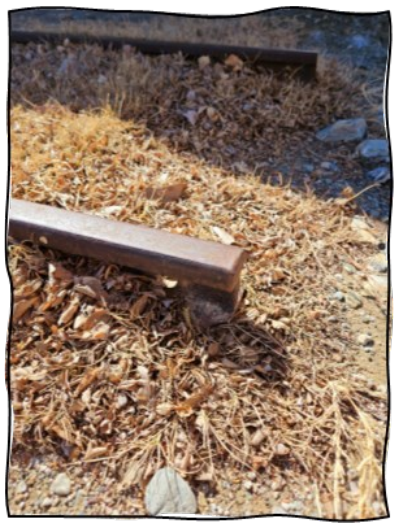Keeler, in these parts famed as the terminus of the Carson and Colorado Railroad, lies seventy miles south of Laws Station. The plan of the railroad entrepreneurs was for a terminus much further southeast, at the Colorado River, but plans change. There were multiple reasons for the change of plans for the Carson and Colorado’s “Slim Princess” line: obtaining rail from England took longer than anticipated; Chinese labor was less available than expected; and a slump in the price of silver meant less business for both the mines and the railroad built to serve them.
 Even before the arrival of the “Slim Princess,” Keeler (formerly Hawley) was a busy mining town, boasting a population of over 7,500 residents, saloons, boarding houses, a theatre, and two hotels. The residents: Mexican, Native American, Chinese, North Americans including Canadians, and Europeans were as diverse as the minerals mined from the area: silver, zinc, talc, marble, asbestos, gold, and borax among others. Miners, muleskinners, gamblers, cocottes, lumber dealers, charcoal dealers, and eventually railroad workers populated this classic Western mining town of multiple saloons, minimal law enforcement, no churches, and infrequent medical care from a horse and buggy doctor. In the 1870s, for reasons unknown, James Marshall Keeler by then a former captain in the U.S. Army, arrived in Hawley. Captain Keeler built mills, established the soda works, sold marble, some of which was used in the San Francisco Mills Building, laid out the town of Hawley which soon became known as Keeler, and lobbied for railroad service. The railroad did indeed come through or at least to Keeler in 1883.
Even before the arrival of the “Slim Princess,” Keeler (formerly Hawley) was a busy mining town, boasting a population of over 7,500 residents, saloons, boarding houses, a theatre, and two hotels. The residents: Mexican, Native American, Chinese, North Americans including Canadians, and Europeans were as diverse as the minerals mined from the area: silver, zinc, talc, marble, asbestos, gold, and borax among others. Miners, muleskinners, gamblers, cocottes, lumber dealers, charcoal dealers, and eventually railroad workers populated this classic Western mining town of multiple saloons, minimal law enforcement, no churches, and infrequent medical care from a horse and buggy doctor. In the 1870s, for reasons unknown, James Marshall Keeler by then a former captain in the U.S. Army, arrived in Hawley. Captain Keeler built mills, established the soda works, sold marble, some of which was used in the San Francisco Mills Building, laid out the town of Hawley which soon became known as Keeler, and lobbied for railroad service. The railroad did indeed come through or at least to Keeler in 1883.
By 1872 steamship services across Owens Lake had cut shipping time to San Pedro by eight days. Steamship service continued to thrive from 1872 to 1882, but ended less than two years before the first steam locomotive saw Keeler. In 1882 the steamship Bessie Brady, by then reconstructed and owned by Captain Keeler, was destroyed by fire. Train service began eighteen months later, initially connecting Keeler with Mound House near Carson City. In the early 1900s the standard-gauged Jawbone Branch between Mojave and Owenyo, just northeast of Lone Pine, connected the Owens Valley with Southern California.
 By the end of World War II track between Laws and Mound House had been relocated or scrapped, but trains continued to run between Laws and Keeler for another fifteen years carrying sheep, cattle, produce, dairy products, ore and minerals, and people. In April 1960 the Keeler Branch was abandoned and the last of the Western railroad common carriers took its place in history. Captain Keeler lived to be only sixty-five years old. He lived to see the Carson and Colorado Railroad serve the mines of the area, and the town that bore his name. But he was spared witnessing the abandonment of the railroad in 1960, and the reduction of the town that bore his name to a population of less than one percent of its 1883 numbers. Although his sojourn in the Southern Owens Valley was brief, Captain James Marshall Keeler left a few significant pages in the history of the what became Inyo County.
By the end of World War II track between Laws and Mound House had been relocated or scrapped, but trains continued to run between Laws and Keeler for another fifteen years carrying sheep, cattle, produce, dairy products, ore and minerals, and people. In April 1960 the Keeler Branch was abandoned and the last of the Western railroad common carriers took its place in history. Captain Keeler lived to be only sixty-five years old. He lived to see the Carson and Colorado Railroad serve the mines of the area, and the town that bore his name. But he was spared witnessing the abandonment of the railroad in 1960, and the reduction of the town that bore his name to a population of less than one percent of its 1883 numbers. Although his sojourn in the Southern Owens Valley was brief, Captain James Marshall Keeler left a few significant pages in the history of the what became Inyo County.
A visit to the town of Keeler is worth any railfan’s time. The old depot still stands, as does the mill, and interpretive signs mounted in local marble honor the town’s railroad history. Smelters on the north shore of Owens Lake are of historic interest as well as being quite photogenic, and those with time, interest, and 4WD can add a visit to Cerro Gordo to their itinerary.
(Reprinted from "The Mail Car" newsletter, Spring 2024)
